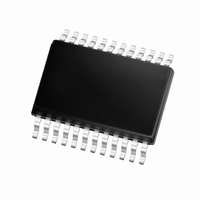MCP3909-I/SS Microchip Technology, MCP3909-I/SS Datasheet - Page 92

MCP3909-I/SS
Manufacturer Part Number
MCP3909-I/SS
Description
IC POWER METERING-1 PHASE 24SSOP
Manufacturer
Microchip Technology
Datasheets
1.MCP3909T-ISS.pdf
(44 pages)
2.MCP3909T-ISS.pdf
(104 pages)
3.MCP3909-ISS.pdf
(40 pages)
Specifications of MCP3909-I/SS
Package / Case
24-SSOP (0.200", 5.30mm Width)
Input Impedance
390 KOhm
Measurement Error
0.1%
Voltage - I/o High
2.4V
Voltage - I/o Low
0.85V
Current - Supply
2.3mA
Voltage - Supply
4.5 V ~ 5.5 V
Operating Temperature
-40°C ~ 85°C
Mounting Type
Surface Mount
Meter Type
Single Phase
Operating Temperature Range
- 40 C to + 85 C
Mounting Style
SMD/SMT
Supply Voltage Range
4.5V To 5.5V
Digital Ic Case Style
SSOP
No. Of Pins
24
Interface Type
Serial, SPI
Supply Voltage Max
5.5V
Rohs Compliant
Yes
Lead Free Status / RoHS Status
Lead free / RoHS Compliant
For Use With
MCP3909EV-MCU16 - EVALUATION BOARD FOR MCP3909MCP3909RD-3PH1 - REF DESIGN MCP3909 3PH ENGY MTR
Lead Free Status / Rohs Status
Lead free / RoHS Compliant
Available stocks
Company
Part Number
Manufacturer
Quantity
Price
Part Number:
MCP3909-I/SS
Manufacturer:
MICROCHIP/微芯
Quantity:
20 000
MCP3909 / dsPIC33F 3-Phase Energy Meter Reference Design
C.10 Active Energy AND REACTIVE ENERGY
C.11 POSITIVE/NEGATIVE ACTIVE ENERGY, POSITIVE/NEGATIVE REACTIVE
DS51723A-page 92
ENERGY AND FOUR-QUADRANT REACTIVE ENERGY
Active energy is defined as the integral of active power over time, which is:
EQUATION C-58:
In this design, active energy is obtained from multiplying the voltage by the current
sampled each time. The phase angle difference is compensated after each power
measurement is completed.
For reactive power, the cumulative reactive energy over a time period can be calculated
by measuring the average power and calculating the time interval between 2 measure-
ments.
EQUATION C-59:
In the measurement plane, the horizontal axis denotes voltage vector U (fixed on the
horizontal axis). The instantaneous current vector is used to represent the power
transfer, and has a phase angle φ against vector U. φ is positive in counter-clockwise
direction. Power exchange can be defined in 4 scenarios:
• Quadrant I (P>0, Q>0): active energy and reactive energy are sent out at the
• Quadrant II (P<0, Q>0): active energy is sent in while reactive energy is sent out;
• Quadrant III (P<0, Q<0): active energy is sent in while reactive energy is
• Quadrant IV (P>0, Q<0): active energy is sent out while the reactive energy is
1. Positive active energy and negative active energy: accumulated active
2. Positive reactive energy and negative reactive energy: If reactive power
same time;
absorbed;
absorbed.
energy can be defined as positive and negative depending on the direction of
active current. When the direction of active current is positive (from power grid to
loads), active energy is positive (where active power P>0, corresponding to
quadrants I and IV, which means that loads are drawing energy from grid). When
current moves from loads to power grid, it is defined as negative active energy
(where active power P < 0, corresponding to quadrants II and III, which means
energy is provided to grid). Usually only positive active energy is taken into
account in active energy, but in practice negative active energy may be taken into
account as well, if necessary.
Q > 0 (corresponding to quadrants I and II), it means power grid is providing
reactive energy to loads, so the energy is defined as positive reactive energy.
When reactive power Q < 0 (corresponding to quadrants III and IV), it means
that loads are providing reactive energy to power grid, so the energy is defined
as negative reactive energy.
W
=
∫
T
0
P t ( ) t d
V
r
=
=
∫
T
0
k
∑
Q
N
=
t ( )dt
0
u k ( ) i k ( )
⋅
⋅
Δ
t
© 2009 Microchip Technology Inc.













